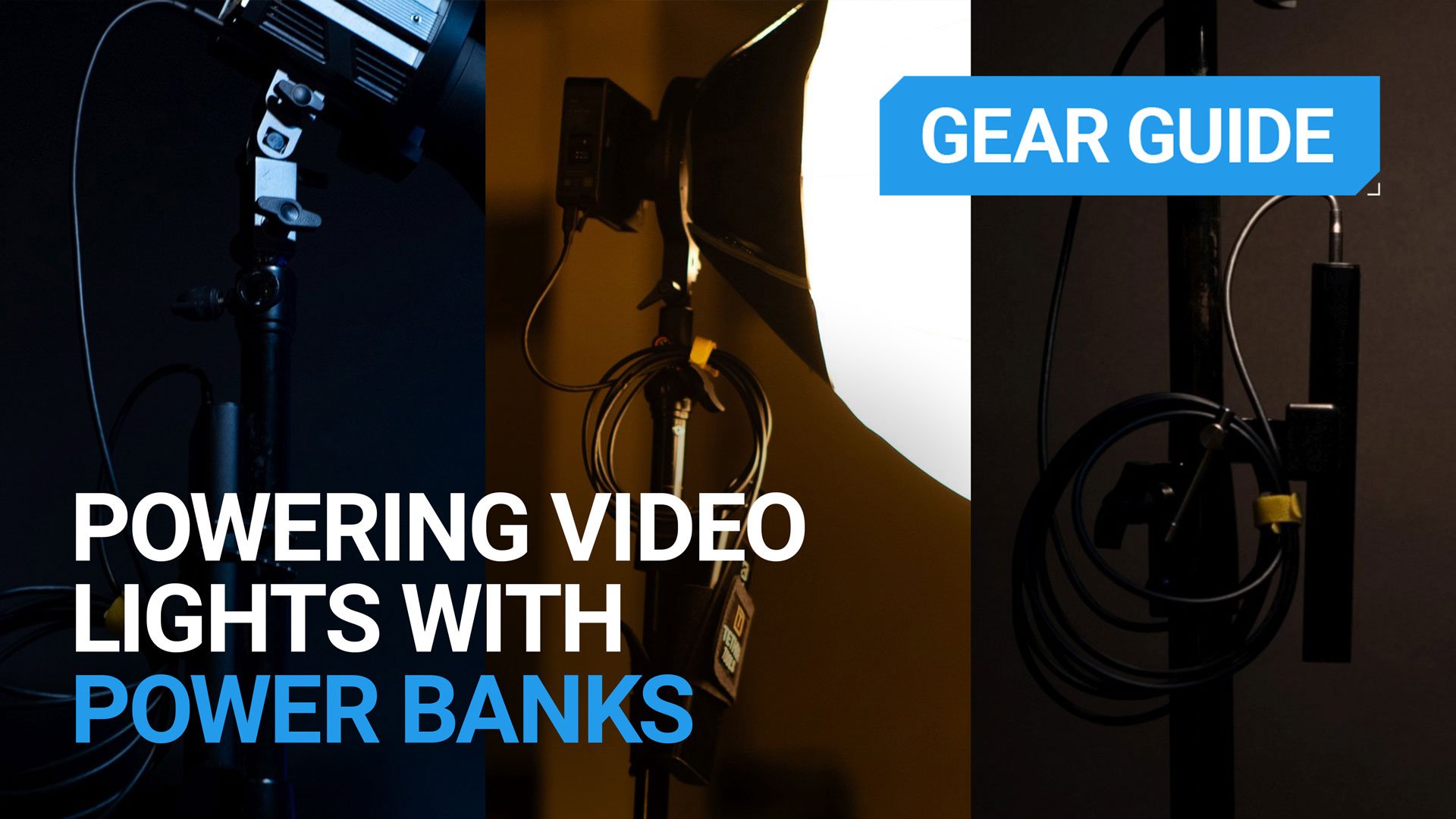
With video LED lights getting more efficient and power banks getting stronger, it is now possible to run a complete set of lights using nothing but power banks. This is huge because it saves a lot of money and a lot of space. There are a few things you need to pay attention to, but in the end, you can carry a full set of lights and the power they need in a small backpack.
The benefit of using power banks for video lights
Running a video light off of power banks is fast, cheaper than any alternative, and easy to set up. This is why small LED panels have been running on batteries for years. But only recently, it became possible to run powerful COB LED lights without a dedicated V-mount battery or a brick connected to the wall.


If you choose the right light, right power bank, and right cable, you will have a tiny setup that needs no dedicated batteries and can fit in a small case. USB banks weigh less, are generally in a comfortable pocket-friendly form factor, and cost less than dedicated video batteries like NPFs and V-mounts.
Here are two batteries: an old v-mount from SWEET, and a more modern power bank from Tether Tools
Choosing an LED light that can run on USB-C power

The fact is that USB-C is rapidly becoming the standard to power small devices. In fact, starting in 2024, it will become mandatory in the EU to have a USB-C port for charging small devices. (even Apple had no choice). Lighting brands that use USB-C to power their lights already have a big advantage going forward. That means that you can still use a USB charger to power those lights, but you can also use a USB power bank for the same cause.
There are three “big league” video lights that support USB-C power, one of them up to 100W, which is some serious power considering the size.
Zhiyun Molus X100

The Zhiyun Molus X100 is by far the king of USB-C-powered lights. At the time of writing this guide (Summer 2023), it is the only 100-Watt light that you can power with a USB bank. It has a unique phone-shaped form factor with an exposed fan, which makes it the smallest 100-watt light on the market today. Depending on the package it runs between $249.00 to $399.00
The pro pack for the Molus X100 does come with an attached battery, but it can also run using a USB port.
Main Features
- Only 100W COB led that supports USBC power
- BI-Color adjustable color temperature
- Small form factor with a unique “flat” design.
- Compatible with both Bowens and zy modifiers
Colbor CL60R

We reviewed the Colbor CL60R a while back and were deeply impressed with the light. If you are looking for portability, it’s just a little bigger than a soda can. One of the nice features of this light is that you can connect a few of those lights together, creating a bigger light source. (see this video for our CL60R connecting hacks).
for about $200, the CL60R is an RGB light which is a big plus if you are considering a light for either effects or mood lighting. There is a Colbor app, so if you are spreading a few of those lights around, you can still control them all from your phone, which may be a plus if you are placing the lights over a big area.
Just like the X100, it uses a Bowens mount, so you can use standard modifiers to soften the light drastically. The light comes with a USB wall port, but you can use the same port for a USB bank.
Main Features
- 65 Watt light
- Full control app
- RGB / Bi-color light
- About the size of a soda can
Zhiyun Molus G60

The Zhiyun Molus G60 is the last light I am going to recommend here, and depending on the package, it goes for between $199.00-$249.00. It’s a 60 watts light from Zhiyun that has a strong focus on portability. And like the X100, it has a tiny form factor, a cube this time. The G60 uses a propriety zy mount system with smaller form factor modifiers, so if you are looking for the kit with the smallest form factor, this would be a good choice.
One of the best features of this light is an adjustable leg that functions either as a light stand swivel or as a way to position the light on the floor or on a tabletop.
Main Features
- 60 Watt light
- small cube-shaped form factor
- Adjustable leg mount
- Compatible with both zy and Bowens mount (via adapter)
Different types of power banks
Not all power banks are created equally. For a power bank to support the high demands of a video light, it needs to have two features: Power Delivery support and 100 Watt output power.
Power Delivery (or PD) is a protocol that communicates the power needs between a USB bank and a device. This is almost a standard with most modern power banks, but you want to make sure that the packaging says Power Delivery or USB-C PD somewhere on the specs of the power bank.
But this is not enough. There are all kinds of profiles for power delivery. You want to make sure that the power bank that you’re buying is able to support the power you need. PD starts as low as 15 Watts, so just seeing “PD” is not enough. For a 60-Watt light, you would want a battery capable of 60 Watts (PD60), and for a 100W light, you’d want a power bank capable of delivering 100 watts of power (PD100).
Lastly, there is capacity. The capacity indicates the “amount of juice” the power bank holds. (and using the same analogy, PD rating is how fast the battery can serve that power). USB banks usually indicate that number in either mAh (milliamps hour), or WH (Watt hour).
The bigger power banks will have about 25,600mAh, which is the same as 100Wh. A 100Wh power bank will power a 100 watts light for one hour. Similarly, a 50Wh power bank will power a 100 watts light for half an hour.
The TL;DR of it is: Get a 100WH power bank with 100 watts PD rating. Here are three options:
ANKER 737 USB-C 24,000 mAh power bank

At $159.99, this is the most impressive unit we’ve seen on the list and the only one that supports the PD3.1 protocol. There are no lights in the market that can take 140W via USB, but it would provide some future-proofing.
Aside from being able to push 140 watts, this power bank also has a great OLED display that shows how much power is left in the battery and how long you can continue to use it at this power. This is incredibly useful if you just want to get quick status read for a shoot. It also shows the draw from each of the ports. This may come in handy to balance brightness and time.
Main Features
- Up to 140 Watts with PD3.1
- Recharges in less than one hour
- Smart OLED display
- Three ports: 140W on either USB-C+18W on USB-A
Tether Tools ONsite USB-C Power Bank (25,600mAh, 150W)

Tether Tools has been around the block with photography, which for me, means they know how to optimize their gear for our needs. For $179.00, the ONsite USB-C power bank can power a 100W LED for an hour or a 60W LED for about 90 minutes.
One of the nice features of this unit is pass-through charging, which means that you can charge the battery and use it at the same time. That means that when if you move into a location where you have access to power, you can top the battery without an interruption to your workflow.
Main Features
- USB-C PD 100 Watts port
- Pass-through charging
- Total of three ports (100W, 27W, 18W)
- Recharge in two hours
UGREEN 145W Power Bank 25000mAh

For about $150.00 this is a robust unit that can power a 100W light for an hour or a 60W light for about 90 minutes. To make things easier for you, there is a digital display that shows the remaining power in the bank with more accuracy than the standard four-LED gauge. It weighs half a kilo, which as you’ll see, is typical for this amount of power.
Main Features
- USB-C PD 100 Watts port
- Total of three ports (100W, 45W, 18W)
- LCD display of remaining power
- Includes a 100W USB-C to USB-C cable
- Recharges at 65W / two hours
Mounting the battery to a light stand



Once you have a light and a power bank, you need to find a way to get them close to one another. If the light goes on a stand, then you would want to secure the power bank to the stand as well.
If your USB cable is long enough, I recommend placing the battery closer to the bottom of the stand. This will give you access if you need a replacement battery but also act as an anchor to balance the stand.
My favorite way to add a battery to a stand is with an accessory called StrapMoore from Tether Tools. It only costs $19.99, and it wraps around both the stand and the battery with velcro. There is some sort of slip-resistant coating on the strap, so it holds very firm.
If you are looking for something more DIY, you can always use a Ball Bungee for about half a dollar a pop. Those are not as firm as the StraoMoore, so they are better used at the bottom of the stand.
Lastly, I sometimes use a combo of a mini-clamp and a phone holder. I am pretty sure I would not go through the trouble of building a unit just for this, but I had something I cobbled together for a different project. Or you can get a pre-made one for pretty cheap.
Using the right cable between the power bank and the light
Just like power banks are not all the same, cables are not made equally as well. The new power requirements coming from delivering 100 watts call for thicker, more efficient cables. And you may be surprised to know, but cables that support the PD protocol actually have a communication chip to make sure that the right amount of power is delivered.
When you go and choose your cable, make sure that it is rated for 100 watts and the PD3.0 protocol (or higher). I am using those cables from UGREEN ($19.99 for two). They are a bit more expensive, but worth it for me because they are more flexible than some of the other brands. That said, there are many other cable makers out there. Just make sure you have the right rating.
FAQ
Look for the mAh rating. For one hour with a 100W light, you want something around 25,000mAh (this is about 100WH)
If you are using a high-power light (60 watts and above), make sure the cables is rated for PD (power delivery) and 100 watts
Most airlines allow up to two batteries of 100WH capacity. That said, it’s best to check with your specific airline. Another thing to note is that most airlines require that you put the batteries in your cabin bag.
Conclusion
We have gone a long way from huge bulky lights and power options to tiny lights and much portable power. If you are in the market for a light up to 100 watts, I encourage you to make sure it supports powering via a USB port. It would mean faster setup, less expenses, and less trunk space.



